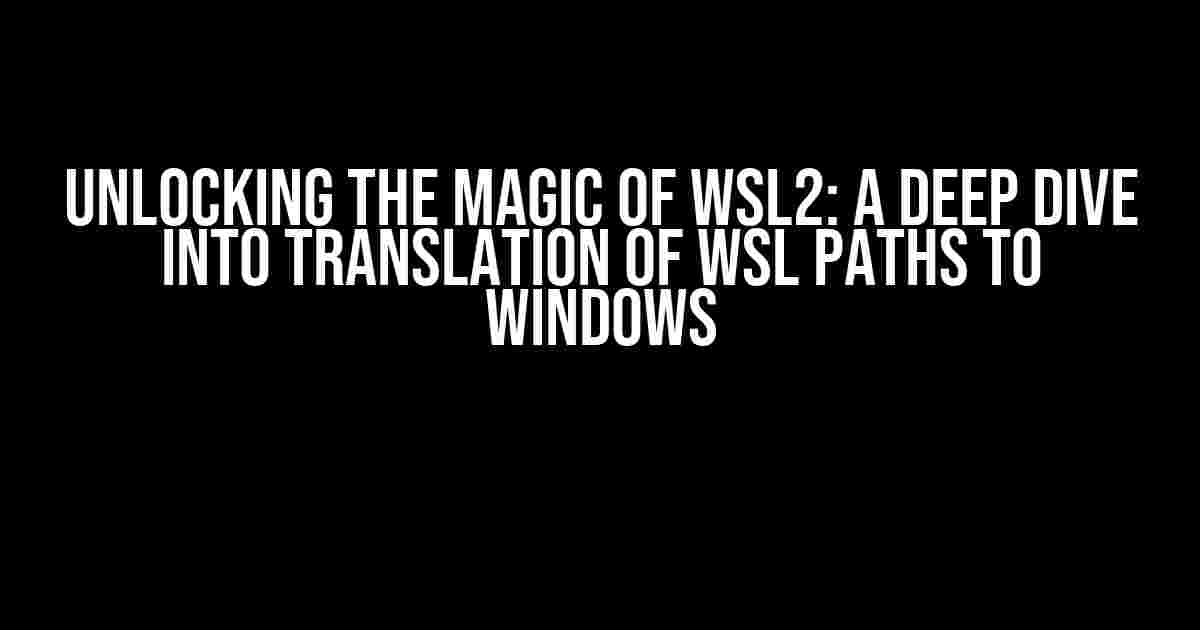Are you tired of wondering how the translation of WSL paths to Windows works when calling “code .” in a WSL2 instance? Do you want to unlock the secrets of interoperability between Windows and Linux? Look no further! In this comprehensive guide, we’ll delve into the inner workings of WSL2, exploring how it achieves seamless path translation, making your development experience smoother than ever.
What is WSL2?
Before we dive into the nitty-gritty, let’s take a step back and understand what WSL2 is. Windows Subsystem for Linux 2 (WSL2) is a compatibility layer that allows you to run Linux distributions directly on Windows 10. It provides a sandboxed environment, where you can install and run Linux binaries, including the popular Visual Studio Code editor.
Why do we need path translation?
In a WSL2 instance, you’re working with a Linux environment, which has its own file system and path structure. However, when you want to open a file or directory in Windows, you need to access it through the Windows file system. This is where path translation comes into play. The WSL2 subsystem needs to translate the WSL path to a Windows path, ensuring seamless interoperability between the two operating systems.
How does WSL2 achieve path translation?
When you call “code .” in a WSL2 instance, the WSL2 subsystem uses a combination of technologies to perform the path translation. Here’s a step-by-step breakdown of the process:
-
WSL2 detects the command
When you enter the “code .” command, WSL2 detects it and recognizes the need for path translation.
-
WSL2 requests path translation from the Windows OS
The WSL2 subsystem sends a request to the Windows operating system to translate the WSL path to a Windows path.
-
Windows OS performs path translation
The Windows OS uses its own path translation mechanism, which involves mapping the WSL path to a Windows path using the following rules:
- The WSL path is converted to a Windows path using the following format:
\\wsl$\<distro_name>\<path> - The Windows OS checks if the path exists in the Windows file system.
- If the path exists, the Windows OS returns the translated path to WSL2.
- The WSL path is converted to a Windows path using the following format:
-
WSL2 receives the translated path
The WSL2 subsystem receives the translated path from the Windows OS and passes it to the “code” command.
-
“code” command opens the file or directory
The “code” command uses the translated path to open the file or directory in Visual Studio Code, allowing you to edit or view the contents.
Examples of path translation
To illustrate the path translation process, let’s consider a few examples:
| WSL Path | Translated Windows Path |
|---|---|
| /home/user/projects | \\wsl$\Ubuntu\home\user\projects |
| /mnt/c/Users/user/projects | C:\Users\user\projects |
| /mnt/d/Projects | D:\Projects |
In the first example, the WSL path /home/user/projects is translated to \\wsl$\Ubuntu\home\user\projects, which is the Windows path equivalent. In the second example, the WSL path /mnt/c/Users/user/projects is translated to C:\Users\user\projects, which is a direct mapping to the Windows file system. The third example demonstrates the translation of a mounted drive, where /mnt/d/Projects becomes D:\Projects.
Troubleshooting path translation issues
In rare cases, you may encounter issues with path translation. Here are some common problems and their solutions:
-
Path not found error
Solution: Ensure that the WSL path exists and is accessible. Check for typos or incorrect path notation.
-
File system permission issues
Solution: Verify that the WSL user has sufficient permissions to access the file or directory.
-
Windows OS version incompatibility
Solution: Ensure that you’re running Windows 10 build 18917 or later, which includes WSL2 support.
Conclusion
In conclusion, the translation of WSL paths to Windows paths is a crucial aspect of WSL2, enabling seamless interoperability between Windows and Linux. By understanding the path translation process, you can efficiently work with WSL2, leveraging the strengths of both operating systems. Whether you’re a developer, a sysadmin, or simply a Linux enthusiast, WSL2 is an excellent way to experience the best of both worlds.
Stay tuned for more exciting articles on WSL2, Linux, and Windows. Don’t forget to share your experiences and tips in the comments below!
References
Disclaimer: This article is intended for informational purposes only and should not be considered as professional advice. The author and publisher assume no liability for any damages or losses incurred as a result of using the information provided.
Frequently Asked Question
Get the inside scoop on how WSL2 translates paths to Windows when you call “code .” in a WSL2 instance!
Q1: What is the magic behind WSL2 translating paths to Windows?
WSL2 uses a translation layer called the “Platform Extensions” to convert Linux paths to Windows paths. This layer is responsible for transforming the Linux file system to a Windows-compatible format, allowing Windows applications like Visual Studio Code to access WSL2 files.
Q2: How does WSL2 handle path separators when translating to Windows?
WSL2 cleverly replaces Linux-style forward slashes (/) with Windows-style backslashes (\) when translating paths. This ensures that Windows applications can correctly interpret and access WSL2 files and directories.
Q3: Are there any limitations to WSL2’s path translation capabilities?
While WSL2’s path translation is robust, there are some limitations. For example, WSL2 may not correctly translate paths that contain unusual characters or are longer than the Windows maximum path length. Additionally, some Windows applications may not fully support WSL2’s translated paths.
Q4: Can I customize the path translation behavior in WSL2?
Yes, you can! WSL2 provides environment variables and configuration options that allow you to customize the path translation behavior to suit your needs. For example, you can set the `WSL_UTF8.DataTableSize` environment variable to specify the size of the translation table.
Q5: Are there any performance implications when using WSL2’s path translation?
WSL2’s path translation can introduce some performance overhead, especially when working with large files or directories. However, the performance impact is generally minimal, and the benefits of seamless integration with Windows applications outweigh the costs.
